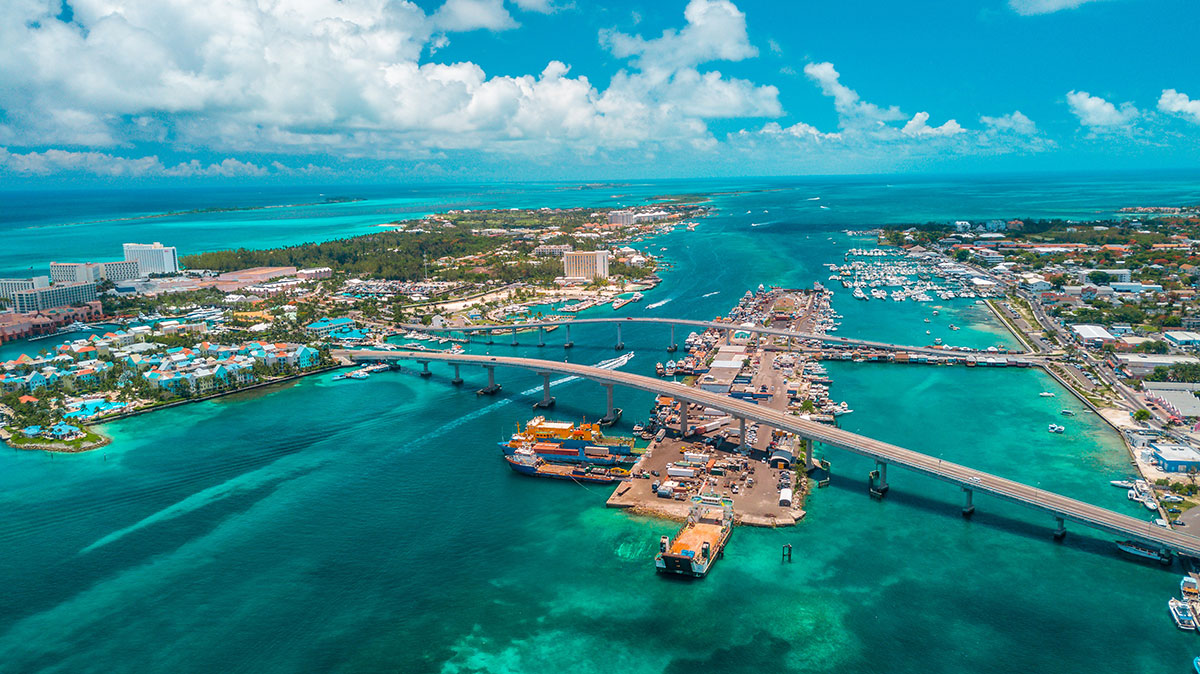Comprised of 700 islands, and over 2,000 rocks and cays, with a population of 389,410. The Bahamas is a small island-nation which sits approximately 80 km, or some 50 miles south-east off the coast of the state of Florida.

The economy is fueled by two main sectors: tourism and financial services. As a small, open economy, The Bahamas relies heavily on trade, which has augured relatively well for its functionality, given its proximity to the United States—its primary trading partner. As an independent nation within the Commonwealth, The Bahamas has achieved significant progress in growth and development since its Independence in 1973 and enjoys a relatively high per capita income (third largest in the Western Hemisphere behind the U.S. and Canada), which has helped to maintain high living standards. The country continues to evolve its legislative, fiscal and monetary framework to meet international best practices, and to support its expanded growth and development.
Economic Composition
The Bahamas is largely an export service economy, almost entirely dependent on tourism and financial services to generate foreign exchange earnings. With a mature tourism infrastructure supporting, on average, approximately 1.4 million stopover visitors and 4.6 million cruise visitors per annum, and a progressive service industry, tourism is the largest driver of the economic activity in The Bahamas. The tourism sector alone (direct, indirect, and induced) provides an estimated 50% of the country’s Gross Domestic Product (GDP) and employs directly or indirectly, nearly 70% of the Bahamian work force. By the end of 2019, The Bahamas boasted a record-breaking 7.2 million visitor arrivals despite disruptions from the passage of Hurricane Dorian in the fall.
The financial services sector contributes approximately 8.9% to the country’s GDP, second only to the dominant tourism sector. The sector has a direct impact on domestic employment and expenditure, while also indirectly affecting other substantial sectors, such as construction, and wholesale & retail trade. In the domestic space, value-added is foremost from the intermediation of the resources and facilitation of payments and settlements for commerce. The international sector exports services and provides benefits more exclusively from employment and local operating expenses.
The financial services sector of The Bahamas is highly developed and dynamic, providing a wide array of services by several types of intermediaries, though its size as a component of the economy has declined in recent years. The sector consists of commercial banks, saving banks, trust companies, offshore banks, insurance companies, a development bank, a publicly controlled pension fund, a housing corporation, a public savings bank, private pension funds, cooperative societies and credit unions. Although financial intermediation is dominated by commercial banks, the insurance industry and the numerous private pension schemes – which constitute the institutional investor base – mobilize a sizeable pool of long-term investment resources for economic growth. Credit unions are also gaining in importance and statutory bodies, such as The Bahamas Mortgage Corporation, The Bahamas Development Bank and the National Insurance Board perform an integral role in the mobilization and intermediation of funds in The Bahamas. Capital and money market activities received a significant boost in 2000 with the introduction of The Bahamas International Securities Exchange (BISX), which operates alongside the informal over-thecounter exchange of public sector bonds and bills, which is administered through the Central Bank of The Bahamas.
Tax Regime
The tax regime in The Bahamas has been historically characterized as simple, with a narrow-base, comprised mostly of indirect taxes. The main types of taxes include customs duty, departure taxes, excise taxes, property taxes, gaming taxes, stamp taxes, and Value Added Tax (VAT). The latter was implemented in 2015 and is now the single most significant contributor to Government revenue. Collectively, tax receipts in The Bahamas represent some 17.5% of GDP and generate the bulk of total Government revenues for the country, which stood at approximately 19.0% of GDP at the end of FY2018/19.
In recent years, the Government has sought to strengthen tax administration by improving and, in some instances, replacing old, antiquated systems, with more efficient digital versions. Key examples of these strides are found in the rollout of the new Electronic Single Window at the Customs Department, and the ongoing Real Property Tax project at the Department of Inland Revenue
Trade
The Bahamas imports most of what it consumes, which is why the current account deficit has historically held a deficit position. However, though the key export of goods (crawfish, polystyrene products, and salt) are generally low in value, exports of services are significant in comparison, given the country’s primary industry. In fact, the export of services led by the stellar tourism performance in 2019, resulted in the current account recording a net surplus of $83.7 million, a turnaround from the $1.5 billion deficit in 2018. The capital and financial account, however, has historically recorded net surpluses, buoyed by a number of FDI projects. These projects, in conjunction with foreign inflows from tourism expenditure, have also supported the strong level of external reserves, which underpins the peg to the US dollar.
Source: Bahamas Economic Recovery Report